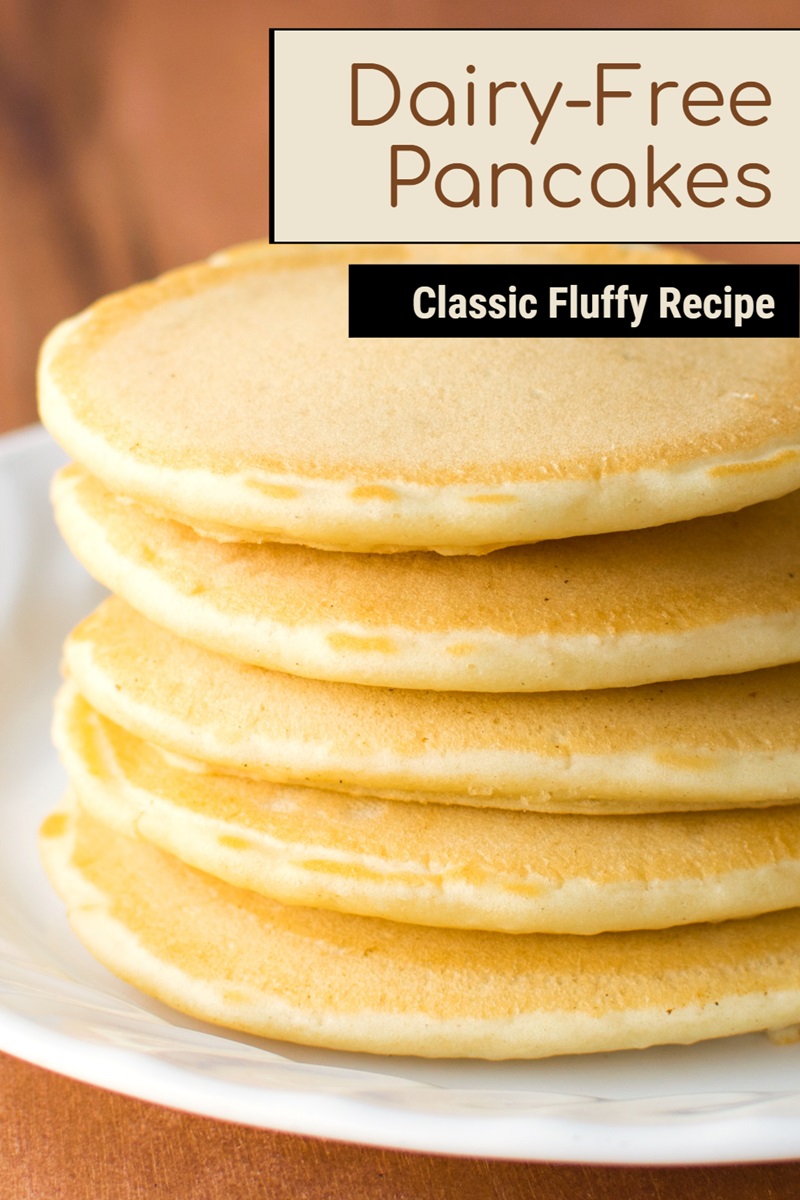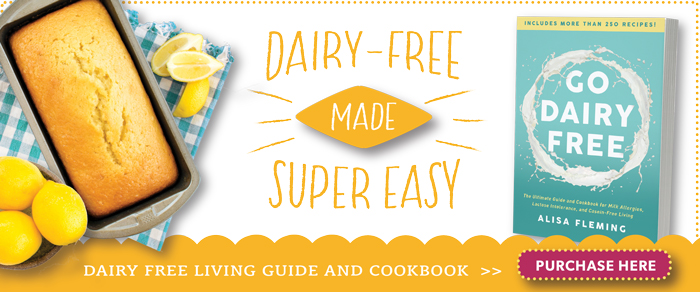One of the beautiful things about pancakes is their simplicity. You really don’t need any mixes or fancy ingredients. In fact, you don’t even need milk or butter alternatives. Just head to your pantry and grab some everyday ingredients to whip up a stack of these tender, fluffy, dairy-free pancakes.

Guide to Your Perfectly Fluffy Dairy-Free Pancakes
This is a simple recipe, adapted from Cafe Delites, that’s quite versatile. Below are FAQs to cover ingredient options, pancake thickness, and tips to easily troubleshoot any issues.
Starter Tip: Dairy-free pancake fluffiness and thickness are affected by many things, but revolve around three core principals: batter thickness, griddle heat, and leavener. These three things are all variables that you can easily control to make your perfect dairy-free pancake height. They’re covered in more detail in the FAQs below.
Can I Use a Different Sweetener?
Definitely! A granulated sugar will work best. If you opt to use a liquid sweetener, start with just 1 1/3 cups water, and add more as needed. I’m not experienced with sugar-free sweeteners, so I can’t say how they will perform in these dairy-free pancakes.
Can I Reduce the Sugar?
You can, but keep in mind, this will affect the flavor and texture a touch. Sugar actually helps in creating that cake-like consistency. These pancakes are just lightly sweet, in my opinion.
Can I Substitute Whole Wheat Flour?
The recipe will still work with whole wheat flour, but the texture will be a little more dense, and you might need to adjust the water a little. For more seamless results, use half all-purpose flour, half whole wheat flour.
What Oil do You Recommend?
I currently use extra-light olive oil (not extra-virgin) as my all-around baking and cooking oil. But your favorite oil for baking should work well. If you opt to use coconut oil, let you egg warm slightly at room temperature and use lukewarm liquid. Coconut oil will solidify and bead up if suddenly hit by any cold liquids.
I Want Buttery Dairy-Free Pancakes. Can I Use Butter Alternative?
You certainly can! I use oil because it is naturally dairy-free, easy to store, less expensive, and found in nearly every kitchen. but you can use dairy-free buttery spread or sticks. Simply melt 1/4 cup of your favorite dairy-free butter alternative. Or, use a butter-flavored oil. Butter alternative can create a thicker batter (especially if refrigerated), so you might need to add a little more liquid.
How Can I Halve this Recipe?
That’s a tricky one. I have tested this recipe with two eggs, so that it could be easily halved. You can halve the entire recipe and use 1 egg, but the resultant dairy-free pancakes do taste a little eggy, in my opinion. Ideally, you would whisk an egg and use half of it. Alternatively, you can used half of an egg substitute or omit the egg and increase the water as needed. Without any egg, pancakes will be a little more fragile and won’t hold their texture quite as well when maple syrup is drizzled on. Or …
Can I Freeze these Dairy-Free Pancakes?
Definitely! This is what we do in our household. To avoid sticking, flash freeze the pancakes by placing them in a single layer in your freezer (on a plate, tray, etc) for 30 minutes to an hour. Then place them in an airtight freezer bag. When ready to enjoy, just pop them in your toaster. Yes, you can enjoy dairy-free toaster pancakes just like waffles! This is a great solution for smaller households and for convenience.
Can I Make the Batter Ahead?
Yes, like most pancake recipes, you can cover and refrigerate the batter until ready to use. It will last for a few days in the refrigerator. This is also a great option for smaller households and making fresh dairy-free pancakes in the morning with little fuss. If you opt to use butter alternative or coconut oil, your batter will thicken when refrigerated. If you need thinner batter, let it warm up a little at room temperature before pouring onto your griddle.
My Batter is Too Thin. What’s Wrong?
If you’ve only added 1 1/2 cups water and your batter is runny and making wide thin pancakes, then you probably need new baking powder. Baking powder creates bubbles and helps to thicken the batter. If it isn’t active enough, your batter will remain thin. To test, put a little baking powder in a bowl and add some boiling water. It should bubble up and fizz vigorously. If it just foams or calmly bubbles, it’s lost potency.
I want Thicker Dairy-Free Pancakes. What Should I Do?
If you’re baking powder is fine, the amount listed will produce quite thick pancakes in many climates. If you live in a very humid climate at sea level or by the ocean, you might want to reduce the liquid to 1 1/3 cups. It can also help to turn the heat on your griddle up a little. If it’s at too low of a temperature, the batter has more time to spread out before it sets. At slightly higher temperatures, it will set more quickly and spread less. But keep an eye out if cooking at medium heat, they will also burn more quickly.
My Batter is Too Thick, What’s Wrong?
The amount of liquid needed seems to vary quite a bit depending on climate and taste. Also, when using water instead of milk, you need to use a little less. Milk actually provides some structure, while water is the purist of liquids. I start with an amount of water that works for dairy-free pancakes at sea level in a humid climate (1 1/2 cups), but you might need 1 3/4 cups or even up to 2 cups of liquid, depending on your climate and if you opt to use milk alternative, coconut oil, or butter alternative.
What’s the Difference Between Using Water and Milk Alternative?
Milk alternatives contain varying ingredients, flavors, densities, etc. In general, milk alternatives will produce a slightly thicker batter, but how much thicker really depends on the type and/or brand. You likely will need to add a little more liquid if using a milk alternative, but how much will vary. Milk alternatives will also influence the taste. Whether they are sweetened or flavored will affect the end result slightly, and the type can also add nuances. For example, almond milk might give the pancakes a hint of nuttiness. Keep all of this in mind if choosing a milk alternative.
Can I Make Bigger Pancakes with this Recipe?
It should work well with larger pancakes, too. My pan is relatively small, and I’m a terrible pancake flipper so I like to make them just a little bigger than dollar sized.

Special Diet Notes: Fluffy Dairy-Free Pancakes
By ingredients, this recipe is dairy-free / non-dairy, nut-free, peanut-free, soy-free, and vegetarian.
For egg-free pancakes, see my Vegan Pancakes Recipe.
For gluten-free pancakes, see my Gluten-Free Vegan Pancakes Recipe.
- 2 cups all-purpose flour
- ¼ cup sugar
- 4 teaspoons baking powder
- ½ teaspoon salt
- ¼ teaspoon baking soda
- ¼ cup oil, plus additional for the pan
- 1 large egg
- 1½ teaspoons vanilla extract
- 1½ cups water, plus additional if needed (can sub dairy-free milk alternative)
- In a large bowl, whisk together the flour, sugar, baking powder, salt, and baking soda until well combined. As you finish whisking, let the ingredients push out to the side to form a large well.
- Add the oil, egg, and vanilla to the well in your dry mix. Give those a quick whisk just to break up the egg. Add 1½ cups water (or milk alternative), and whisk the ingredients in the center while gradually incorporating the flour mixture. The batter should be fairly thick, but still able to pour. Whisk in more water as needed if it's too thick (up to ½ cup more depending on your climate, altitude, and desired thickness). But try to avoid overmixing. Some lumps are okay.
- Let the batter sit for 15 minutes or so, then preheat your griddle or frying pan over medium-low heat and add a little oil to grease.
- The batter should be a little thick, but if it's too thick, whisk in a little more water as needed. Thicker batter bakes up taller, while thinner batter will give you flatter pancakes that still have a fluffy texture.
- Pour a scant ¼ cup of batter per pancake onto your preheated surface. Cook until the bubbles are popping and the edges look dry. Flip, and cook for 1 to 2 minutes more, or until golden.
- Remove the pancakes to plates, and repeat with the remaining batter.



2 Comments
These come out perfect every time! My family loves them!
I’m so happy to hear this Kristi! Thank you for the feedback.